51 Years Later: "Ohio", Kent State & Tin Soldiers Still Marching | #MayThe4thBeWithYou
51 years ago, on May 4, 1970 at ~12:25 PM, a school shooting took place on the campus of Kent State University, Ohio.


Richard Milhous Nixon - 37th President of the United States (1969 - 1974)
Remember those days when students were brave enough to march in the streets and end a war?
Now that today's college students have been safely muzzled by crippling loan debt, there is little need for authority to teach students a lesson similar to that educational day of May 4, 1970. It's been 50 years since shots rang out across a college campus, leaving four dead in Ohio and the lives of so many of that generation changed forever by the day's events.
And so, the tin soldiers march on and on... in Baton Rouge. Baltimore. Ferguson. Minneapolis. Louisville. Our hometowns.
So we here at Thrasher's Wheat look forward, as we look back to that fateful day at Kent State. In the meantime, rest assured that the mainstream media will ignore this anniversary of real news, while busy fabricating the latest fake news.
Some believe that a conspiracy covering up the true motivations behind the shootings that involved James Allen Rhodes, Governor of Ohio and President Richard Nixon. (See the book Four Dead in Ohio: Was There a Conspiracy at Kent State by William A. Gordon
"13 seconds in Kent Ohio" - A tribute to those hurt or injured at Kent State Ohio on May 4th 1970. Song By Crosby, Stills, Nash & Young, and performed by Dala.

Kent State Massacre Evidence
Federal Bureau of Investigation (FBI) 11/15/73 document
via Kent State Truth Tribunal
(Click photo to enlarge)
On April 3, 2013,Kent State Truth Tribunal’s submission to the United Nations was posted ONLINE at the UN Human Rights Committee website.
The Federal Bureau of Investigation (FBI) 11/15/73 document (above) shows the shipment of 12,000 weapons within possession of the Ohio National Guard (ONG) including weapons used to kill and wound student protesters at Kent State University on May 4, 1970 with commentary on the destruction of 12,000 weapons.

Kent State Massacre Evidence
US Dept of Justice letter 11/19/73
via Kent State Truth Tribunal
(Click photo to enlarge)
The US Dept of Justice letter 11/19/73 pertains to Mr. Terry Norman -- a critical link in the Kent State Ohio Massacre Coverup.

70 Seconds Before Kent State Shootings
May 4, 1970 @ 12:24 PM
Kent State Truth Tribunal
So what really happened at Kent State, Ohio in 1970?
Based on last week's U.S. Department of Justice (DOJ) investigation report, we still might never know. Or will we someday learn the awful truth of that tragic day that left 4 dead in Ohio?
It seems that the key to the truth lies with Terry Norman.
In recently discovered film of the Kent State Shooting in 1970 (1:07.40 thru 1:08), FBI informant provocateur Terry Norman (photo at top) is the young man in the light colored sports jacket. Earlier that day Norman's mentor, Detective Tom Kelly from the Kent Police had attempted to have Norman's gun approved for carrying on campus during the demonstrations, but that approval never came so it's KEY that the video clearly shows Norman handing over his gun to Detective Kelly.
From Kent State: Was It about Civil Rights or Murdering Student Protesters? | Project Censored (September 11, 2012) By Laurel Krause of Kent State Tribunal with Mickey Huff:
Mangels wrote in the Plain Dealer, “Norman was photographing protestors that day for the FBI and carried a loaded .38-caliber Smith & Wesson Model . . . five-shot revolver in a holster under his coat for protection. Though he denied discharging his pistol, he previously has been accused of triggering the Guard shootings by firing to warn away angry demonstrators, which the soldiers mistook for sniper fire.” [4. Mangels, “Kent State Tape Indicates Altercation and Pistol Fire Preceded National Guard Shootings (audio),” Plain Dealer (Cleveland), October 8, 2010, http://www.cleveland.com/science/index.ssf/2010/10/analysis_of_kent_state_audio_t.html.]From forensic evidence expert Stuart Allen's analyses of the Kent State Tape in 2010, we learned that Norman shot that weapon at the May 4th demonstration as he was attacked & beat-up by students who saw his gun. (More on Terry Norman ~ Does Terry Norman Hold the Key to Kent State?.)
Video footage and still photography have recorded the minutes following the “sound of sniper fire,” showing Terry Norman sprinting across the Kent State commons, meeting up with Kent Police and the ONG. In this visual evidence, Norman immediately yet casually hands off his pistol to authorities and the recipients of the pistol show no surprise as Norman hands them his gun. [5 [5.] Kent State Shooting 1970 [BX4510], Google Video, at 8:20 min., http://video.google.com/videoplay?docid=-3727445416544720642.]
Watching these Kent State videos without sound, Norman's gun hand-off coupled with the post-Kent State Tape analysis, we now understand the importance of this interaction caught on video & at many other sources.
Norman's pistol 'created the sound of sniper fire.'
In response to the DOJ whitewash report Congressman Dennis Kucinich issued a statement:
“The letter also failed to indicate any efforts to reconcile the evidence in the recording with any prior statements about the incident made by FBI paid informant, Terry Norman, who was on campus that day and was known to have brandished a gun that might have created the sounds caught in the recording.
“While I appreciate the response from the Justice Department, ultimately, they fail to examine key questions and discrepancies. It is well known that an FBI informant, Terry Norman, was on the campus. That FBI informant was carrying a gun. Eye witnesses testified that they saw Mr. Norman brandish that weapon. Two experts in forensic audio, who have previously testified in court regarding audio forensics, found gunshots in their analysis of the audio recording.
Kent State Massacre - (Find The Cost of Freedom; Vietnam) + Nixon/The fall of Saigon - YouTube
Did an FBI informant discharge a firearm at Kent State?
From New light shed on Kent State killings | The Washington Times - Tuesday, May 4, 2010 by James Rosen:
Declassified FBI files show the FBI already had developed credible evidence suggesting that there was indeed a sniper and that one or more shots may have been fired at the guardsmen first.Did an FBI informant precipitate the shootings?"
Rumors of a sniper had circulated for at least a day before the fatal confrontation, the documents show. And a memorandum sent to FBI Director J. Edgar Hoover on May 19, 1970, referred to bullet holes found in a tree and a statue — evidence, the report stated, that “indicated that at least two shots had been fired at the National Guard.”
Another interviewee told agents that a guardsman had spoken of “a confirmed report of a sniper.”
It also turned out that the FBI had its own informant and agent-provocateur roaming the crowd, a part-time Kent State student named Terry Norman, who had a camera. Mr. Norman also was armed with a snub-nosed revolver that FBI ballistics tests, first declassified in 1977, concluded had indeed been discharged on that day.
Then there was the testimony of an ROTC cadet whose identity remains unknown, one of the pervasive redactions concealing the names of all the FBI agents who conducted the interviews and of all those whom they interrogated. Although presumably angry over the demonstrators’ destruction of the campus ROTC building, the cadet’s calm, precise firsthand account nonetheless carries a credibility not easily dismissed.
Before the fatal volley, the ROTC cadet told the FBI, he “heard one round, a pause, two rounds, and then the M-1s opened up.”
The report continued that the cadet “stated that the first three rounds were definitely not M-1s. He said they could possibly have been a .45 caliber. … [He] further stated that he heard confirmed reports of sniper fire coming in over both the National Guard radio and the state police radio.”
The cadet also told the FBI he observed demonstrators carrying baseball bats, golf clubs and improvised weapons, including pieces of steel wire cut into footlong sections, along with radios and other electronic devices “used to monitor the police and Guard wavelengths.”
Why is understanding the Kent State Ohio Massacre critical?
To understand the events of May 4, 1970 at Kent State and the four dead in Ohio, is to understand much of what has happened in our history before, during and after.
In the intervening years, there have been a wide range of commissions, studies, research and theories of what actually led to twenty-eight Ohio National Guardsmen shooting into a crowd of anti-war protesters at Kent State University which left four college students dead on the ground.

Photo by Kent State photojournalism student John Filo
"History never exactly repeats itself.
But its currents are never far from the present. As today’s protesters and police employ bolder tactics, the Kent State and Jackson State anniversaries should remind us that deadly mistakes can and do happen. It is the government’s responsibility to wield proportionate force, not to over-arm police and place them in a position where they could panic with deadly results."
~~ Steven Rosenfeld, Will a Militarized Police Force Facing Occupy Wall Street Lead to Another Kent State Massacre? | Civil Liberties | AlterNet
Despite many official denials, there have always been persistent theories that the National Guard was actually provoked into the shootings by a belief that they were being fired upon themselves and therefore were acting in self defense.
What follows is a brief recap for those less familiar with the The Kent State Massacre, followed by the latest developments.
The spring of 1970 was a time of significant unrest on college campuses protesting the Vietnam war and President Richard Nixon's announcement of a new American invasion of Cambodia, provoking an escalation in anti-war protests. The anti-war protest movement culminated with the Kent State Massacre which resulted in hundreds of universities, colleges, and high schools closing throughout the United States due to a student strike of four million students. The official President's Commission on Campus Unrest concluded that "the indiscriminate firing of rifles into a crowd of students and the deaths that followed were unnecessary, unwarranted, and inexcusable."

Twenty-eight Ohio National Guardsmen fired sixty-seven rounds in thirteen seconds, leaving four students dead
Here is a summary of recent new developments from Kent State Truth Tribunal. (For more, see Kent State Truth Tribunal. Thanks Laurel for all of your work in your sister Allison's name.)

"They were about to walk out on stage and were spending a moment warming up."
Photo by Henry Diltz
Immediately after the Kent State shooting on May 4, 1970, Neil Young composed the song "Ohio" after looking at photos appearing in Life magazine and then taking a walk in the woods. Crosby, Stills, Nash, and Young went to the studio and recorded the song which was released to radio stations shortly after the killings.
A rather significant article in The Cleveland (Ohio) Plain Dealer "Neil Young's 'Ohio' evokes strong images of May 4, 1970 shootings at Kent State" by Mark Dawidziak:
It was more than just another protest song.
Ohio was a cry of anguish, penned by Neil Young after seeing pictures taken at Kent State University on May 4, 1970.
But 40 years after members of the Ohio National Guard opened fire on college students, Young's "Ohio" remains the most evocative pop-culture response to a defining moment in American history.
"This is an event that now is in every history book," said Carole A. Barbato, a Kent State University professor of communication studies who team-teaches a course on May 4. "Wherever you live, even though your environment obviously shapes how you perceive things, you're probably as aware of the shootings at Kent State as those of us in Northeast Ohio. And even though this still would be in the history books, the pop culture certainly does perpetuate that. "Ohio" was entering the pop-culture consciousness within three weeks of the shootings.
"It was the quickest and best reaction to Kent State, with Neil Young acting as 50 percent songwriter and 50 percent journalist," said David Bianculli, a pop-culture historian who teaches at Rowan University and regularly contributes to NPR's "Fresh Air."
"I'll tell you what that song meant," said Bianculli, author of the recently published "Dangerously Funny: The Uncensored Story of the Smothers Brothers Comedy Hour." "After the assassinations of Martin Luther King and Bobby Kennedy, you felt kind of helpless as a young person. It seemed that when someone had your voice, that voice was silenced, usually by violence.
"Then you have Kent State, and college kids are actually fired upon. And when you just might start to be thinking, you don't dare have a voice or there is no voice, from the radio comes this voice of solidarity and outrage. It wasn't just a pop song."
...
"After 1970, that doesn't happen again. It didn't need to happen again, mostly because it didn't need to happen there. And that's what Neil Young's song spoke to."
Thanks Ken D.
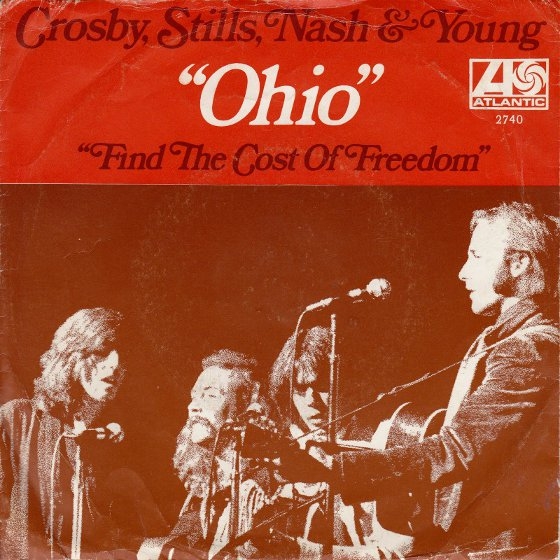
"Ohio" 45 Atlantic Records Single (w/ "Find The Cost of Freedom")
by Crosby, Stills, Nash & Young - May 1970
More on Neil Young composed song "Ohio" performed by Crosby, Stills, Nash & Young (CSNY).
Timeline of Events Leading up to May 4, 1970:
Let us continue the struggle to ensure that Allison's murder (& Bill's, Jeffry's and Sandra's) was not in vain.




The Four Dead in Ohio
Allison Krause - Age: 19, 110 YardsWilliam Schroeder - Age: 19, 130 Yards
Jeffrey Miller - Age: 20, 90 Yards
Sandra Scheuer - Age: 20, 130 Yards
A video collage of still images commemorating the 36th Anniversary of the killing of four college students by National Guardsman at Kent State in 1970
Also, see "My 285th post on Kent State." Why the 1960s still matter by Will Bunch. Let a million flowers bloom.
The Girl in the Kent State Photo
On May 4, 1970 my sister Allison was shot to death around noon as she protested against the expanding Vietnam War and the US military occupation of her college campus, Kent State University. Ever since May 1970, American leadership, Kent State University and US government agencies involved in the Kent State Massacre planning, the execution and the aftermath have never claimed that the murders at #KentState were at the hands of the US government … or that it was even murder at all.
To restate this conundrum, US military bullets killed and injured American students at a peace rally. The US troops shot armor-piercing bullets from American war weapons, killing four students, critically wounding nine yet ever since that day, American leadership has never referred to or reflected on the fact that young people and protesters were shot dead by US military personnel with US military weapons. A drastically different view (fostered mostly by #truth) will forever be held by most of the Baby Boomers, the real target on this great US government onslaught. Just after Kent State, EVERYBODY KNEW they meant to #kill at Kent State … and 10 days later in a related show of force, two additional American students were shot dead at Jackson State University, with the tally at six students in May 1970.
This long-gone American history show us how the US government has gotten away with murder against American young adults and protestors … now going on 44 years.
~~Laurel Krause
Today marks 49 years since the 1970 Kent State shooting. Watch @TheGrahamNash's powerful 2013 #SternShow performance of @CSNofficial's #Ohio — written by @Neilyoung and originally recorded in response to the tragic incident. #SaturdaySoundtrack pic.twitter.com/iHdbgVX6dC— Stern Show (@sternshow) May 4, 2019
From Neil Young News @ Thrasher's Wheat: A Happy New Year for 2018's "Children of Destiny" on the state of today's "Protest Music": The protesting of state sponsored brutality and violence continues, but where are the musical anthems that capture the emotions of our times? From Billboard | 'Fear of Being Blackballed' Prevents Artists From Releasing Protest Music:
Neil Young was so shaken by photos of the four unarmed students killed by military gunfire at Kent State that he wrote "Ohio" for Crosby, Stills, Nash & Young right away. By the end of the week, it was playing on the radio. That was 1970. Now, in 2014, outrage over police brutality has become much more widespread, inspiring protests and "die-ins" nationwide for Michael Brown and Eric Garner, two unarmed black men killed in confrontations with cops. Days ago in Brooklyn, two NYPD officers were murdered while sitting in their patrol car. But this year will end without a defining protest song. ... "I think a lot of it is just due to fear of being blackballed and not making a living," Questlove of The Roots told Billboard, referring to the backlash the Dixie Chicks faced in 2003, when Natalie Maines told an audience that the band was "ashamed" that President Bush was from Texas. "We were like, 'Man, if a white woman can lose her career in the United States for speaking up for what's right, then shit, we'll get the electric chair.' I think that was the bottom line. And that just really rendered America silent."
OK Star Wars fans on #StarWarsDay! Know your true history of May 4, 1970 at Kent State Univ., Ohio & Nat'l Guard shooting into a crowd of anti-war protesters https://t.co/ZKUgfJU6oZ … May The FOUR Be With You #MayThe4thBeWithYou @CSNofficial @thedavidcrosby @Neilyoung ☮️❤️ pic.twitter.com/QAFn1H6Y69
— ThrashersWheat (@ThrashersWheat) May 4, 2019
Labels: Crosby Stills Nash Young, csny, kent state, neil young, ohio










































 Human Highway
Human Highway

















 Concert Review of the Moment
Concert Review of the Moment





 This Land is My Land
This Land is My Land

 FREEDOM In A New Year
FREEDOM In A New Year








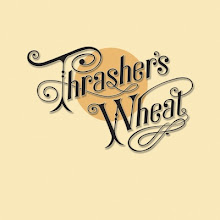
 *Thanks Neil!*
*Thanks Neil!*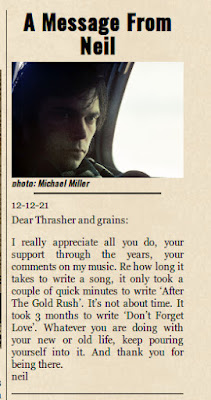




![[EFC Blue Ribbon - Free Speech Online]](http://www.thrasherswheat.org/gifs/free-speech.gif)











 The Unbearable Lightness of Being Neil Young
The Unbearable Lightness of Being Neil Young Pardon My Heart
Pardon My Heart



 "We're The Ones
"We're The Ones  Thanks for Supporting Thrasher's Wheat!
Thanks for Supporting Thrasher's Wheat!




 This blog
This blog 
 (... he didn't kill himself either...)
#AaronDidntKillHimself
(... he didn't kill himself either...)
#AaronDidntKillHimself

















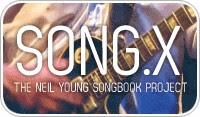




































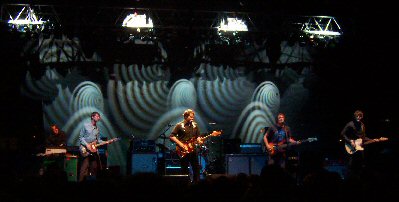

















 Neil Young's Moon Songs
Neil Young's Moon Songs




 Civic Duty Is Not Terrorism
Civic Duty Is Not Terrorism Orwell (and Grandpa) Was Right
Orwell (and Grandpa) Was Right


 What's So Funny About
What's So Funny About 



5 Comments:
This comment has been removed by the author.
I was nine years old when this happened. My brother was in college and he had been hit in the head by a cop during a massive protest. I was very close to my brother. I think this was the first time I ever really had the thought that there are many people in authority who do not care about anything but power and control. It was a feeling of dread for my brother. And then several of his friends went to Vietnam and did not come back. We should not forget Nixon's war crimes and we should not forget that he was a real slime bag. He did lasting damage. A trail of ruin, hypocrisy, corruption and death. Don't forget. I think I'll hot the peace trail.
Please don't dominate the rap Jack
if you got nothing new to say
If you please don't back up the track
This train got to run today
Spent a little time on the mountain
Spent a little time on the hill
Heard some say better run away
Others say you better stand still
Now I don't know but I been told
it's hard to run with the weight of gold
Other hand I heard it said
it's just as hard with the weight of lead
Who can deny? Who can deny?
it's not just a change in style
One step done and another begun
in I wonder how many miles?
Spent a little time on the mountain
Spent a little time on the hill
Things went down we don't understand
but I think in time we will
Now I don't know but I been told
in the heat of the sun a man died of cold
Do we keep on coming or stand and wait
with the sun so dark and the hour so late?
You can't overlook the lack Jack
of any other highway to ride
It's got no signs or dividing lines
and very few rules to guide
Spent a little time on the mountain
Spent a little time on the hill
I saw things getting out of hand
I guess they always will
I don't know but I been told
if the horse don't pull you got to carry the load
I don't know whose back's that strong
Maybe find out before too long
One way or another
One way or another
One way or another
this darkness got to give
One way or another
One way or another
One way or another
this darkness got to give
Robert Hunter
Real News is Hard to Find. You post it here.
Alan in Seattle
@Alan: I completely agree! Well put my friend.
Peace🙏
Post a Comment
<< Home